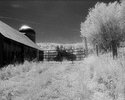Having read this entire thread so far, I will endeavor to reply to the OP and implicitly a few others who have touched on aspects of my own view; and will attempt also to include a new element for consideration by those who may find it interesting. However, I will have to limit what I say about it, in order to avoid straying into areas, such as international policymaking, that are not directly germane to the thread.
I will be making a presentation on B&W film photography this weekend; we’ll see who, besides my daughter and a friend, may come. In preparation, I have researched the rebound in various ways, including calling U.S. camera stores and distributors. While I can’t quantify “strong” from the OP’s question, it is indeed true, from everything I know, that film and processing sales volumes are continuing to increase. One Midwest camera store, which is also a distributor, said half its (growing) film business is now B&W.
I also know that the majority of the sales are driven by a younger sector of the population, reportedly 18-35; that the vast majority is color; and that some celebrity appearing on so-called social media platforms favored by young people, sporting some specific disposable or other P&S camera, immediately produces a sale spike. So, yes, a retro fad is driving the sales, as far as I know.
However, I am neither a statistician nor a social scientist. I do have nearly 50 years’ experience engaged in global political, economic, and cultural matters nearly daily, and my view with respect to the rebound of film photography derives from my knowledge of aspects of that context. I think there’s something very interesting underneath it. I don’t suggest that film will rise to anything like its former levels, but perhaps it is part of, a reflection of, a more profound change occurring historically.
A neighbor of mine, a recently retired high-level IT engineer for one of the top companies, suggested several years ago a book he had just read, “The Revenge of Analog: Real Things and Why They Matter” (2016). The author explores a number of areas of older technologies regaining some lost ground, as well as certain cited failures of other features of the rise of digital, for instance, computers in classrooms. He records and remarks on characteristic comments that have been subsequently borne out in various studies, indicating that—I’ll say it this way, not wishing to spark reaction—there is something about engaging in physical processes and unmediated, deliberate person-to-person communication that tends to resonate in us.
This coheres with what I see as a thread weaving through countless interviews, articles, comments, blogs, etc. on film photography. Those in the smaller percentile who go beyond the casual use of a camera for snapshots (others in this thread have already noted that the majority has always used photography for simple snapshots since the technology allowed it) say that they like that the film camera, in comparison with digital media, requires them to slow them down and makes them think about what they are doing; they like the physical process; they like producing a physical product; they like the limitations it imposes; some express the excitement of anticipation in not being able to instantly see the capture. The director of the film-based Bronx Documentary Center, a photojournalist, in a recent interview noted that U.S. recent-generation children have many times not produced much with their hands.
If I can express the following view without over-stepping the proper line of this forum, I will say that I believe that many very significant changes are afoot in the world that will tend to make quite a few people begin to think about how positive change from many of today’s broad problems may best be brought about, and that the kind of interest that underlies the new engagement not only with film photography but other “analog” technologies, will cohere with some of the answers that arise in the discussion. We invent technologies of all sorts; how we define our relationship to their use sometimes takes some sorting out.





 , I don't have many good answers other than my own feelings and opinions I guess; I just generally prefer the look of film images these days, but I think older digital cameras which perhaps were trying to attract the film crowd over definately feel like they offer something more akin to 'filmic' looks than say more modern over sharpened digital images with XXXMB images.
, I don't have many good answers other than my own feelings and opinions I guess; I just generally prefer the look of film images these days, but I think older digital cameras which perhaps were trying to attract the film crowd over definately feel like they offer something more akin to 'filmic' looks than say more modern over sharpened digital images with XXXMB images.

